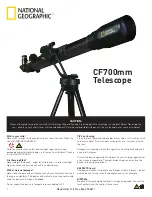
Celestar Manual
5
INTRODUCTION
Welcome to the Celestron world of amateur astronomy! For more than a quarter of a century, Celestron
has provided amateur astronomers with the tools needed to explore the universe. The Celestar line of
telescopes continue in this proud tradition combining large aperture optics with ease of use and portability.
With a mirror diameter of 8 inches, your Celestar telescope has a light gathering power of 841 times that of
the unaided human eye. Yet despite its large aperture, the Celestar optical system is extremely compact
and portable because it utilizes the Schmidt-Cassegrain design. This means you can take your Celestar
telescope to the mountains or desert or wherever you observe.
The Celestar telescope is made of the highest quality materials to ensure stability and durability. All this
adds up to a telescope that gives you a lifetime of pleasure with a minimal amount of maintenance. And,
your Celestar telescope is versatile
−
it grows as your interest in astronomy grows.
Your Celestar telescope however, is not limited to astronomical usage alone. It can also be used for
terrestrial viewing to study the world around you. All you need to do is take the time to familiarize
yourself with your Celestron telescope and its operation.
HOW TO USE THIS MANUAL
This manual is designed to instruct you in the proper use of your Celestar telescope. The instructions are
for assembly, initial use, long term operation, and maintenance. There are seven major sections to the
manual. The first section covers the proper procedure for setting up your Celestar telescope. This includes
setting up the tripod, attaching the telescope to the mount, balancing the telescope, etc.
The second section deals with the basics of telescope use. Topics include focusing, aligning the finder, and
taking your first look. The third section deals with the basics of astronomy which includes the celestial
coordinate system, the motions of the stars, and polar alignment. The fourth section deals with celestial
observing covering visual observations of the planets and deep-sky objects. Using both the setting circles
and star hopping are discussed. The fifth section covers celestial photography working from the easiest to
the most difficult. The last major section is on telescope maintenance, specifically on cleaning and
collimation. Keeping your Celestar telescope in proper collimation is the single most important thing you
can do to ensure it performs well.
In addition to the major sections mentioned previously, there is a list of optional accessories for your
Celestar telescope that include a brief description of its purpose. This is the section to consult when you’ve
mastered the basics and ready for new, more challenging observations. The final part of this manual
contains a list of objects that can be observed through your Celestar telescope. Included are the
coordinates for each object, its brightness, and a code which indicates what type of an object it is. In
addition, there is a list of bright stars used for aligning the setting circles.
Read the assembly instructions through completely before you attempt to set up your Celestar telescope.
Then, once you’ve set up your Celestar telescope read the section on ‘Telescope Basics’ before you take it
outside and use it. This will ensure that you are familiar with your telescope before you try to use it under
a dark sky. Since it will take a few observing sessions to familiarize yourself with your Celestar telescope
you should keep this manual handy until you have fully mastered your telescope’s operation. After that,
save the manual for future reference.
Содержание Celestar 8
Страница 1: ...1 CELESTAR INSTRUCTION MANUAL ...
Страница 4: ...Celestar Manual 4 TECHNICAL SPECIFICATIONS 78 FURTHER READING 79 ...
Страница 9: ...Celestar Manual Assembling your Celestar 9 Figure 2 1 Celestar 8 Figure 2 2 Celestar8 Deluxe ...
Страница 52: ...Celestar Manual Celestial Photography 52 ...






























